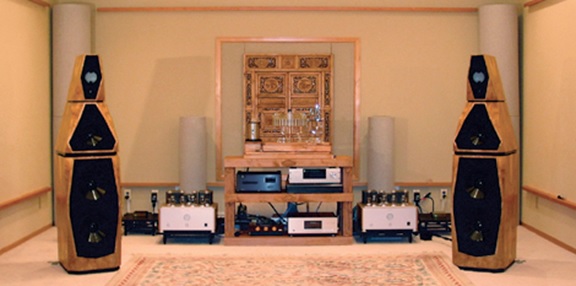With the advancement in direct laser projection, the reproduction and accuracy of colors is getting more attention. Commercial units are already available and operating from several makers, including Christie Digital, Barco, NEC, etc. Beside the traditional “size” of the color gamut, and the output (white) lumens, more emphasis is being given to the next level of specifications, including Color Light Output (CLO) and Color Volume. It should not be long before every direct laser projector has full adjustability to display any brightness and any colors in the universe, as desired.

The question is: what should the display images look like? Should they look like the original objects under the original “natural” lighting conditions? Or, should they simply be displayed according to the artist’s creation concept or the viewer’s liking? One can get some insights of the issues by going back in time and referencing the development of Hi Fi audio systems.
Thomas Edison invented the first practical sound recording and playback system using a cylindrical medium in 1877. It was mass-produced and became popular from the late 1880s until around 1910. Then, it was replaced by a lower cost round platter, the gramophone record, which lasted till recent times and was, sadly, replaced by tapes, CDs, erasable memories, and, finally, Wi-Fi streaming systems. During all this time, microphones, amplifiers and loudspeaker systems were developed to produce sounds that replicate the original sounds so closely that the systems are referred to as High Fidelity (Hi-Fi) system.
Besides replicating the original sound, further development in stereophonic systems were aimed at replicating the original sound, but with the extra space dimensions. With the advancement of digital techniques, it is not uncommon for sound systems to have five or more speakers placed around the listener, aiming at replicating the original space dimensions even more accurately.
 This audio system surely has the widest “sound gamut” of all systemsI am not sure how many music listeners have listened to a real musical instrument without electronic interception and modifications, and are able to tell the difference between the “real” sound and the sound from the loudspeaker of the “Hi-Fi” system. The final result is that “Hi-Fi” system makers are trying to provide a system that can reproduce the original sound, but additionally offer many advanced features. For example, in older systems, there are many “knobs” for adjusting the various parameters, like bass, treble, loudness, echo, etc. For newer systems, with a push of a button, you can immerse yourself in the famous concert halls of your choice around the world. You can even listen to a rock concert inside Wiener Musikverein in Vienna, with your eyes closed sitting in your own home. The original sound, as a result, is transformed to many types of sound, not the original, but to a more pleasing sound that the listener prefers. I am not sure there is anything wrong with this picture, which has been around for many years and is still the mainstream in the audio industry. As a matter of fact, I prefer expanded sound myself, making my living room much larger than it really is, regardless of what the original recordings are.
This audio system surely has the widest “sound gamut” of all systemsI am not sure how many music listeners have listened to a real musical instrument without electronic interception and modifications, and are able to tell the difference between the “real” sound and the sound from the loudspeaker of the “Hi-Fi” system. The final result is that “Hi-Fi” system makers are trying to provide a system that can reproduce the original sound, but additionally offer many advanced features. For example, in older systems, there are many “knobs” for adjusting the various parameters, like bass, treble, loudness, echo, etc. For newer systems, with a push of a button, you can immerse yourself in the famous concert halls of your choice around the world. You can even listen to a rock concert inside Wiener Musikverein in Vienna, with your eyes closed sitting in your own home. The original sound, as a result, is transformed to many types of sound, not the original, but to a more pleasing sound that the listener prefers. I am not sure there is anything wrong with this picture, which has been around for many years and is still the mainstream in the audio industry. As a matter of fact, I prefer expanded sound myself, making my living room much larger than it really is, regardless of what the original recordings are.
Let’s get back to color image display systems. I used to play around with the knobs when I had an old TV where the luminance and chrominance knobs were right on the front panel and were easily accessible. I made adjustments until I felt the TV picture was “good” even if I had to get up from my sofa to make the adjustments. The adjustments were not based on technical inputs or measurements. They were all based on what I thought the colors of the main objects look like, e.g. the face, the apple, etc. I could not usually get to where I wanted it to be, but it was the best I could do.
For new digital HDTVs, I do not have adjustment knobs. Instead, I have to access various pop-up menus, which cover the images being viewed during adjustments. As a result, even though I do not have to get out of my sofa to make the adjustments, I seldom change anything after the initial setup, even though I would like to do so sometimes. It is just too disruptive to change as long as it is “acceptable”, especially if the people around me watching the same TV are happy, immersed into the program, and do not know the differences.
Using the newly developed direct laser projection systems with larger color gamut, higher CLO and larger color volume, it becomes possible to display images with more accurate colors and better brightness ranges. On the other hand, what gets displayed depends on the choices of the viewers as long as they are provided with one or more control knobs.
At this time, I believe that the direct laser projection system has much larger display color gamut than that of the image capturing system with a smaller camera color gamut. I specifically use the term “camera color gamut” as digitally created images can have a color gamut that is much larger than any display color gamut achievable today. Most color cameras separate colors using color filters having line widths, which are too wide for good color capture due to illumination brightness limitations. Narrow line widths equate to low efficiencies requiring higher illumination brightness. Without a “good” camera with a large color gamut, the ‘non-Hi-Fi’ starts right here.
Most of the images we are presented with on TVs and in movie theatres are not “real”. They are pleasing images tailored and presented by the artists, the producers and the directors and making use of the full capabilities of the display color gamut. As a matter of fact, in movie presentation, the goal seems to be to replicate the image color standards of emulsion film projection and not the original real object colors, using digital systems. In recent times, more and more animated movies are made using artificially chosen colors, which in theory could have a larger color gamut than the available display color gamut. Who decides on the chosen color gamut for image generation and who decides on what to display, are the real questions. Does the animation artist actually see the “real” colors of the chosen colors on the computer screen? The fact is, the chosen color is represented by numbers and the display screen color is limited by the screen color gamut, which is quite small as most displays use color filters with wide line widths for creating the desired colors.
The situation is further complicated because the light illumination of the original scene uses different types of light sources with different spectra, usually specified by correlated color temperature and color rendering indices. For example, objects illuminated with midday sunlight, evening sunlight, incandescent lamps, arc lamps, LEDs, etc., will look different in color. What we see is the combination of the “original” color of the object together with the color of the illumination light . In extreme cases, a red light illumination source makes everything red (with varying red color brightness) and a blue light illumination source makes everything blue.
As we all know by now, image processing and modification are much easier than audio processing and modifications. For example, changing the colors of specific objects in an image is much easier than changing the sound quality of a particular musical instrument in a piece of symphonic music. Imagine you want an image of a fresh strawberry for a movie scene with a fruit basket. Slightly “un-fresh” strawberries can be purchased if one is running out of time. After capturing the image of the scene, the color of the strawberry can be changed easily to a color that makes it look fresh again.
Which one is un-fresh and which one is color modified? Which picture would you buy for use in your advertisement?I was made aware of a situation recently by a friend of mine. A commercial artist he knows always tries to deliver accurate color for images used in web commerce. The feedback was that color accuracy did not matter. If the customer did not like the colors in the delivered files, even if they were accurate, the delivered files were rejected and had no commercial value.
It is definitely important for direct laser systems to be designed and made with the largest possible color and brightness adjustment boundaries. At the same time, it is important to be aware that the customers are ultimately the one who decide and set the displayed images according to their needs and preferences. For movie theatres, the color preferences of the movie goers will determine how the image are to be projected, and these, in turn, are determined and affected by what they see in the real objects around them, printed materials in shopping malls, video games, and more importantly, the color of the Pokémon they are chasing after everyday!
– Kenneth Li

